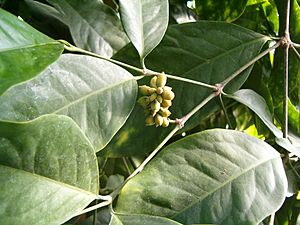Melinjo facts for kids
Quick facts for kids Melinjo |
|
|---|---|
 |
|
| Conservation status | |
| Scientific classification | |
| Genus: |
Gnetum
|
| Species: |
gnemon
|
The Gnetum gnemon is a special type of tree. It is found in places like Southeast Asia and islands in the western Pacific Ocean. You can find it from Mizoram and Assam in India, all the way to Indonesia, Malaysia, the Philippines, Fiji, and even Hawaii in the United States.
People call this tree by many names. Some common ones are gnetum, joint fir, two leaf, melinjo, belinjo, bago, and tulip.
What is the Melinjo Tree?
Unlike many other plants in its family, which are lianas (vines that climb), the melinjo is a small to medium-sized tree. It can grow very tall, up to 15–22 meters (about 50-72 feet). Its trunk can be as wide as 40 centimeters (about 16 inches).
The leaves of the melinjo tree stay green all year round, so they are called evergreen. They grow in pairs and are about 8–20 cm long and 3–10 cm wide. When they first appear, they are a bronze color, but they turn a shiny dark green as they get older.
The tree has special parts that look like fruits, but they are not true fruits. These are called female strobilus (like cones). They have a thin skin and a large, nut-like seed inside, which is about 2–4 cm long. The male strobili are small and grow on long stalks. They can look a lot like flowers.
It's easy to mistake this plant for a flowering plant because its "fruits" look like real fruits, its leaves are wide, and its male parts look like flowers. This is an example of convergent evolution, where different plants develop similar features.
Besides the tree form, there are also some types of melinjo that grow as shrubs.
The "fruits" (fleshy strobili) weigh about 5.5 grams each, and the seed inside weighs about 3.8 grams. These "fruits" usually ripen from June to September in places like the northeastern Philippines. When they turn red and are ripe, birds, mammals, and reptiles like to eat them.
What is it Used For?

The nuts from the melinjo tree are eaten in many ways across Southeast Asia and Melanesia. People boil them, roast them, or eat them raw. The young leaves, the "flowers" (male strobili), and the outer part of the "fruits" are also edible after they are cooked. People in Indonesia, the Philippines, Thailand, Vanuatu, Papua New Guinea, the Solomon Islands, and Fiji enjoy them. They have a slightly sour taste and are often added to soups and stews.
In Indonesian cuisine, the melinjo is very popular and is called melinjo or belinjo. The seeds are used to make a sour vegetable soup called sayur asem. They are also made into raw chips that are later deep-fried to become crispy crackers called emping. Emping is a type of krupuk (Indonesian crackers). These crackers have a slightly bitter taste and are often served as a snack or with Indonesian meals.
The melinjo plant is grown a lot in the Aceh region of Indonesia. It is seen as a very important vegetable. The male strobili, young leaves, and female strobili are used in a traditional vegetable curry called kuah pliek. This special dish is served during important traditional events and celebrations. In the Pidie district, women pick the ripe red "fruits" and use them to make keureupuk muling, another type of cracker.
Images for kids
See also
 In Spanish: Gnetum gnemon para niños
In Spanish: Gnetum gnemon para niños




